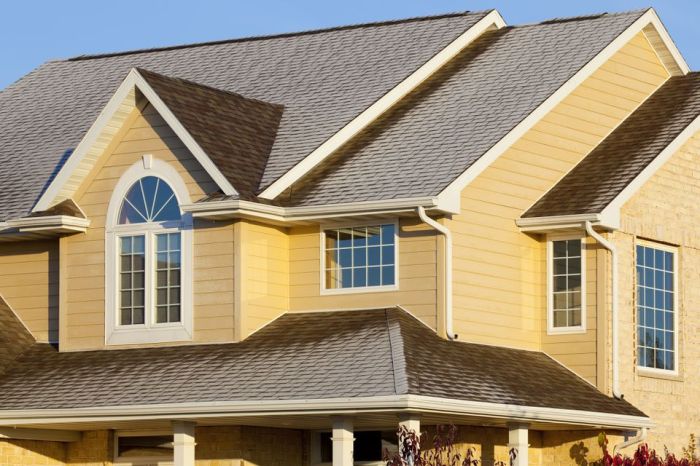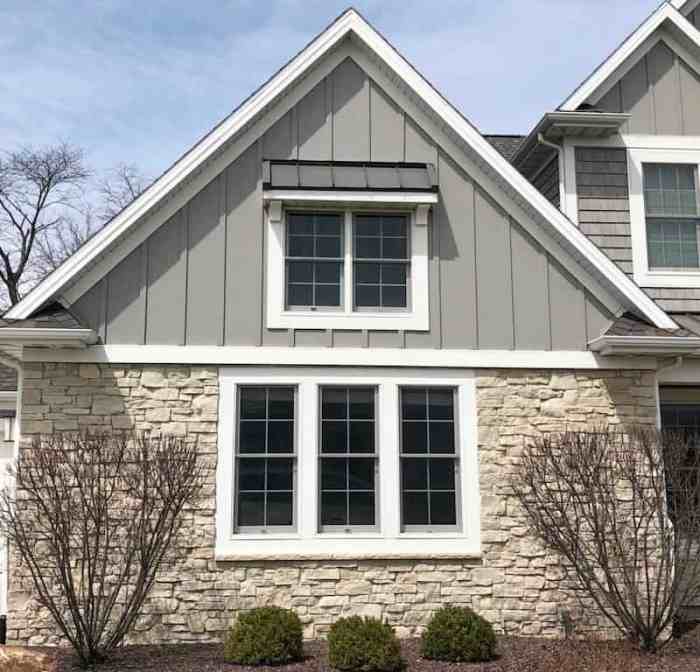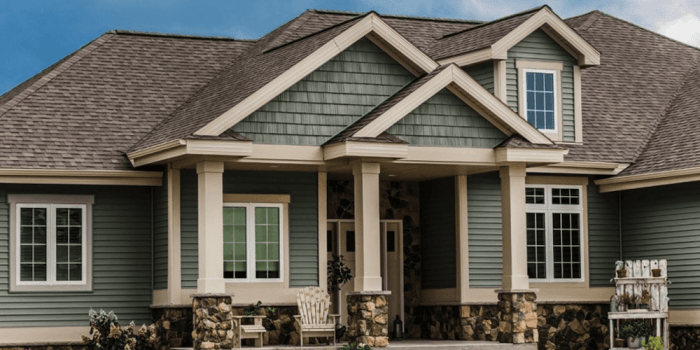Best House Siding Options: A Comprehensive Guide
Kicking off with the best house siding options, this guide aims to provide a detailed exploration of the various materials available, their pros and cons, and factors to consider when choosing the right siding for your home.
Types of House Siding Options

When it comes to choosing the right siding for your house, there are several options available in the market. Each type of siding material has its own unique characteristics, pros, and cons. Let's explore some of the common house siding options:
Vinyl Siding
- Vinyl siding is a popular choice due to its affordability and low maintenance.
- Pros: Durable, available in a variety of colors, resistant to rot and insects.
- Cons: Not as environmentally friendly, can crack or fade over time.
Fiber Cement Siding
- Fiber cement siding is a versatile option that mimics the look of wood or stucco.
- Pros: Fire-resistant, durable, low maintenance, and resistant to rot and pests.
- Cons: Can be heavy and require professional installation, more expensive than vinyl.
Wood Siding
- Wood siding offers a natural and traditional look to your home.
- Pros: Aesthetic appeal, environmentally friendly, can be painted or stained.
- Cons: Requires regular maintenance, susceptible to rot, insects, and weather damage.
Brick Siding
- Brick siding provides a classic and elegant appearance to your house.
- Pros: Long-lasting, fire-resistant, low maintenance, and energy-efficient.
- Cons: Expensive upfront cost, can be challenging to repair or replace individual bricks.
Durability and Maintenance
When considering house siding options, it is crucial to evaluate the durability and maintenance requirements of each material. This will help you choose a siding that not only looks good but also stands the test of time.
Durability Factors
- Vinyl Siding: Vinyl siding is known for its durability, as it is resistant to rot, insect damage, and moisture. It can last anywhere from 20 to 40 years, depending on the quality of the material.
- Fiber Cement Siding: Fiber cement siding is extremely durable and can withstand harsh weather conditions, such as strong winds and heavy rain. With proper maintenance, it can last up to 50 years or more.
- Wood Siding: Wood siding is susceptible to rot and insect damage if not properly maintained. However, with regular maintenance, including staining or painting every few years, it can last 20 to 40 years.
- Aluminum Siding: Aluminum siding is durable and resistant to rust and corrosion. It has a lifespan of around 20 to 40 years with proper care and maintenance.
Maintenance Requirements
- Vinyl Siding: Vinyl siding requires minimal maintenance, usually only needing to be cleaned with a mixture of water and mild soap. It may need occasional power washing to remove dirt and grime.
- Fiber Cement Siding: Fiber cement siding requires periodic painting to maintain its appearance and protect it from the elements. Regular inspections for cracks or damage are also recommended.
- Wood Siding: Wood siding needs to be inspected regularly for signs of rot or insect infestation. It should be stained or painted every few years to prevent moisture damage.
- Aluminum Siding: Aluminum siding is low maintenance and typically only needs to be cleaned with a mild detergent and water. Inspections for dents or scratches should be done periodically.
Longevity Comparison
When comparing the longevity of different siding options, fiber cement siding tends to outlast other materials, with a lifespan of up to 50 years or more. Vinyl siding and aluminum siding can also last for several decades, while wood siding may require more frequent maintenance to reach its maximum lifespan.
Cost Comparison

When it comes to choosing house siding options, one crucial factor to consider is the cost involved. The initial installation costs and long-term maintenance expenses can vary significantly depending on the type of siding you choose.
Factors Affecting Cost
- Variety of Materials: Different siding materials come at varying price points. Vinyl siding tends to be more affordable compared to natural wood or fiber cement.
- Installation Complexity: Siding options that require more intricate installation processes may result in higher labor costs.
- Longevity and Maintenance: Consider the long-term maintenance requirements of each siding material to evaluate overall costs over time.
Cost-Effective Options
For those on a tight budget, vinyl siding is often a cost-effective choice due to its low initial installation costs and minimal maintenance needs. Fiber cement siding is another durable and budget-friendly option that can mimic the look of wood without the high price tag.
Aesthetics and Design
When it comes to house siding, aesthetics and design play a crucial role in enhancing the overall look of a home. The choice of siding material can significantly impact the curb appeal and visual appeal of a house. It is essential to select a siding option that complements the architectural style and design elements of the home.
Aesthetic Appeal of Various House Siding Materials
- Wood Siding: Provides a classic and timeless look, adding warmth and charm to a home. It can be stained or painted in various colors to match the design scheme.
- Brick Siding: Offers a traditional and elegant appearance, exuding a sense of durability and sophistication. It comes in various shades and sizes to create unique patterns.
- Vinyl Siding: Comes in a wide range of colors and styles, offering versatility and affordability. It can mimic the look of wood, stone, or other materials.
- Fiber Cement Siding: Resembles the look of wood or masonry but with lower maintenance requirements. It provides a modern and sleek appearance to a home.
Enhancing Curb Appeal with Different Siding Options
- Consider the architectural style of the house when choosing siding to ensure harmonious integration with the overall design.
- Use contrasting colors or textures to create visual interest and highlight architectural features of the home.
- Mixing siding materials can add depth and dimension to the exterior, creating a unique and personalized look.
- Pay attention to details like trim, shutters, and accents to enhance the overall aesthetic appeal of the house.
Choosing Siding that Complements House Design
- Take into account the color palette, texture, and scale of the siding material in relation to the rest of the house's design elements.
- Opt for siding that enhances the architectural style of the home, whether it's modern, traditional, rustic, or contemporary.
- Consult with a design professional or use online visualization tools to preview different siding options on your home before making a final decision.
- Seek inspiration from exterior design trends and neighboring homes to ensure your choice of siding complements the surrounding environment.
Energy Efficiency

When it comes to choosing the right house siding, considering the energy efficiency of different materials is crucial. The type of siding you choose can have a significant impact on your heating and cooling costs, as well as overall energy consumption.
Additionally, opting for eco-friendly siding options can not only benefit the environment but also help you save on energy bills in the long run.
Energy Efficiency of Different Siding Materials
Each siding material has its own level of energy efficiency. For example, insulated vinyl siding can provide better insulation for your home, reducing heat loss in the winter and heat gain in the summer. On the other hand, fiber cement siding is also known for its energy-saving properties due to its durability and ability to resist extreme weather conditions.
Impact on Heating and Cooling Costs
The choice of siding can directly impact your heating and cooling costs. Siding materials with high energy efficiency can help regulate indoor temperature more effectively, reducing the need for excessive heating or cooling. This, in turn, can lead to lower energy bills and increased savings over time.
Eco-Friendly Siding Options for Energy Savings
Opting for eco-friendly siding options such as wood, bamboo, or recycled materials can offer energy-saving benefits. These materials are sustainable, renewable, and often provide natural insulation properties, helping to reduce energy consumption and increase overall energy efficiency in your home.
Closing Summary
In conclusion, understanding the different house siding options, their costs, durability, aesthetics, and energy efficiency can help you make an informed decision to enhance the look and functionality of your home.
FAQs
Which house siding option is the most cost-effective?
Vinyl siding is often considered the most cost-effective option due to its low initial installation costs and minimal maintenance requirements.
How can I improve the energy efficiency of my home with siding?
Opting for insulated siding materials can greatly improve the energy efficiency of your home by reducing heating and cooling costs.
What factors should I consider when choosing house siding for a coastal area?
For coastal areas, it's important to choose siding materials that are resistant to salt corrosion and can withstand high winds, such as fiber cement or metal siding.